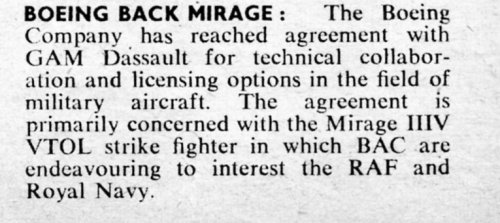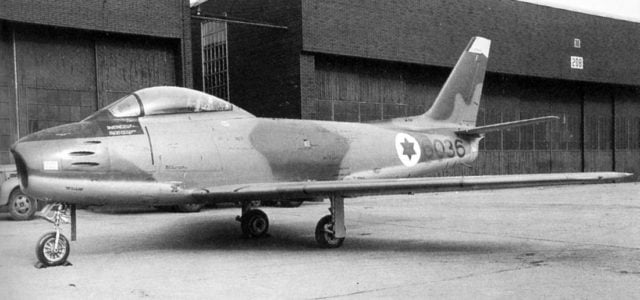Boeing, Dassault Forming V STOL Team
Wichita, Kan.-Boeing Co. and Marcel Dassault have teamed formally to collaborate in technical and sales efforts on vertical and short takeoff and landing aircraft programs.
Three specific agreements have been signed by the two companies with the approval of the U. S. and French governments and direct liaison has been established between the two companies.
Dassault’s immediate line of contact with Boeing is the American company’s Military Aircraft Systems Division (MASD), here. Agreements, expected to be announced this week, basically cover these areas:
- Technical evaluation of the V/STOL Dassault Mirage 3V by Boeing’s MASD. This is planned to ensure that the program represents technologies that will not only fit North Atlantic Treaty Organization requirements in the NBMR—S strike fighter competition—adding whatever Boeing knowledge may enhance the airplanes performance—but also to incorporate U S. military system requirements that would make the Mirage 3V a potentially useful system to U. S. services with minimum modifications. This agreement also pledges Boeing to support the Mirage 3V fully in NATO and U. S. markets, and gives MASD the option of building the strike fighter in this country. Dassault has a similar agrccmcnt covering Britain with British Aircraft Corp. (A\V July 30, p. 18).
- Similar understanding covering a V/STOL assault transport. proposed in the NATO NBMR-4 competition, is incorporated in a second Boeing-Dassault agreement.
- Rights to Dassault-developed V S'I'OL thrust control system, covering sales and production in the United States by MASD, are included in the third agreement.
Under the technical collaboration agreement, MASD will tap its own engineering resources at Wichita. It also will be able to call for assistance on any of Boeing's other divisions which it feels have specialized knowledge and equipment fitting any portion of the 3V’s needs. Interchange will provide free passage of unclassified data. Classified material will have to be approved for transmission between the two companies by their respective governments.
Initial contributions by Boeing to the Mirage 3V include advice regarding fuel systems design technology, data on the effects of sonic fatigue on structure and personnel—a vital area due to the large number of engines in the airplane which develop high noise levels—and information on long-life, fail-safe structures. Dassault laison with Boeing is directly with MASD. Boeing Vice president and division general manager, Edward C. Wells, is the key man, with authority to make decisions reflecting Boeing policy.
MASD Exploratory Studies Manager Donald D. Hufford will coordinate and implement the agreements in Wichita. Herbert S. Clayman, recently assigned by MASD as European manager with offices in Paris, will manage the program at its source. T. E. Lollar, a division aerodynamics and dynamics stability specialist, is being moved to the Paris office to act as liaison during the tethered and flight test program, being carried out by Dassault on the Mirage 3V Balzac, approximately a half- scale testbed of the Mirage 3V.
Boeing collaboration with Dassault on the new program actually is a follow-on to the U. S. company's earlier working arrangements with the French manufacturer. The arrangements involved an unsuccessful attempt to fulfill an informal Dept. of Defense requirement for a lightweight, simplified fighter-bomber, a competition in which the Northrop N-156 and Lockheed F-104 also participated. Boeing and Dassault, working together on a general policy basis and operating agreements never made formal, jointly entered the Dassault Mirage 3W, which actually was a Mirage 3C modified to meet DOD desires for an airplane that would be able to operate out of relatively unprepared fields, have relatively unsophisticated fire control and electronics equipment and feature some degree of self—sufficiency in combat.
The 3W was fitted with larger tires, its rocket pack was deleted, simpler Aida radar replaced the more complex Cyrano equipment, and a self—contained starting system was incorporated in the design. Proposal by the two companies last March contemplated manufacture of the prime equipment by the U. S. companies under license to satisfy DOD's reluctance to rely on foreign supply sources. For example, Pratt & Whitney would be assigned the manufacture of the 3W’s Snecma turbojct engine and Hughes Aircraft would provide the Aida radar.
This earlier collaboration provided Boeing management with insight into Dassault capabilities. With growing interest in V/STOL programs evidenced by NATO and the US. indicating a firm market developing in the near future, the American company decided to leap-frog its own research and development programs by utilizing what appeared to be a definite lead by European designers in actual V/STOL hardware.
Other agreements by U. S and European companies—Pratt & Whitney and Bristol Siddeley, Rolls-Royce and Allison, Ling-Tcmco-Vought and Short Bros. & Harland (A\V Sept. 10, p. 30)— also influenced the Boeing decision. Boeing probably sees the agreement with Dassault as providing considerable benefits in developing its own technologies and considers the Mirage 3V as not merely the means to an end, but as providing invaluable broad—based additional V/STOL technology which can be applied to future programs.
MASD engineers appear to have developed considerable respect for the French company’s attitude and ability to make decisions to build hardware to flight—test concepts at an earlier stage than is prevalent in U. S.—where the design constantly is refined on the drawing board and in the wind tunnel until it is in danger of being obsolete before being built.
The Boeing engineers point out that as a result of the 3V Balzac testbed program, Dassault expects to roll out and start flight tests on the full-scale Mirage 3V strike fighter in late 1963 and believes it can have the airplane operational with the French air force in quantity by 1966.




